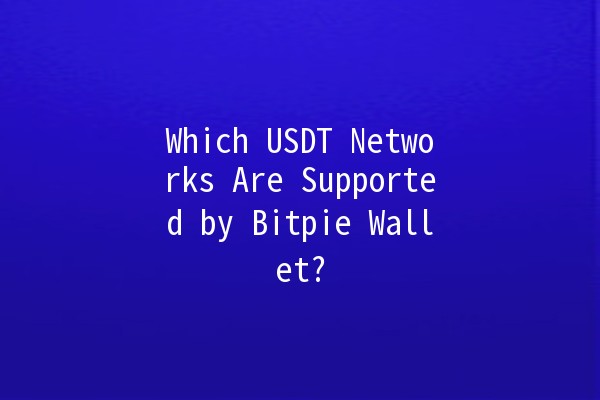
to Bitpie Wallet and USDT
In the dynamic landscape of cryptocurrency, wallets play a crucial role in helping users manage their digital assets securely. One such wallet is the Bitpie Wallet, a popular choice for many crypto enthusiasts. Bitpie Wallet not only provides a secure environment for storing various cryptocurrencies but also offers extensive support for various USDT (Tether) networks. In this article, we will explore which USDT networks are supported by Bitpie Wallet and delve into valuable practices to maximize your usage of USDT through this wallet.
Understanding Tether (USDT)
Tether (USDT) is a stablecoin that is pegged to the value of traditional fiat currencies, predominantly the US Dollar. This peg aims to provide stability in the often volatile cryptocurrency market, making it a popular option for traders and investors who want to mitigate risks. USDT allows users to transact on various blockchain networks, making it an essential asset in the crypto ecosystem.

USDT Networks Supported by Bitpie Wallet
Bitpie Wallet supports multiple networks for USDT transactions. Understanding these networks is crucial for users who want to optimize their transactions and interactions. The primary networks supported by Bitpie Wallet include:
Overview: The Ethereum network is one of the most popular blockchain platforms for smart contracts and decentralized applications (dApps).
Application: USDT on the Ethereum network utilizes the ERC20 standard, enabling users to send, receive, and trade USDT seamlessly on various exchanges and wallets that support Ethereum.
Overview: Tron is known for its high throughput and low transaction fees, making it an attractive choice for users.
Application: The TRC20 standard version of USDT allows for cheap and quick transactions, especially useful for users engaging in frequent trades or transfers.
Overview: The Omni Layer protocol is built on the Bitcoin blockchain, allowing for the creation of tokens on Bitcoin.
Application: Although not as commonly used as ERC20 or TRC20, USDT on Omni caters to users who prefer Bitcoinbased transactions.
Overview: EOS is a blockchain platform designed for building decentralized applications with high scalability.
Application: Bitpie Wallet supports USDT on the EOS network, providing users with access to the rapid and efficient transaction capabilities of EOS.
Overview: Liquid Network is a sidechain built on Bitcoin that enhances transaction speed and confidentiality.
Application: The Liquid version of USDT is ideal for users looking to transact securely and privately on a Bitcoinbased infrastructure.
Enhancing Your Productivity with Bitpie Wallet and USDT
To make the most out of your Bitpie Wallet and USDT, here are some practical productivity tips:
Description: Take advantage of Bitpie Wallet’s ability to interact with multiple networks.
Application: For example, if USDT on the Ethereum network has higher liquidity on a certain exchange, consider swapping your Tronbased USDT for ERC20 USDT to execute your trades more effectively.
Description: Use APIs or trading bots that work with Bitpie Wallet.
Application: Set up automated trading strategies, taking advantage of price discrepancies between various USDT markets while minimizing transaction time.
Description: Each network has its transaction fees, which can vary significantly.
Application: Before initiating a transaction, check current fees across supported networks. Choose the network with the lowest fees for your transaction size to maximize savings.
Description: Familiarize yourself with Bitpie Wallet's features, including security settings and transaction history.
Application: Turn on twofactor authentication for added security and regularly review your transaction history to track expenses and savings.
Description: Utilize online communities and forums related to Bitpie and USDT.
Application: Learning from others’ experiences can provide insights into tips, tools, and strategies that you may not have considered.
Frequently Asked Questions
The best network for USDT transactions largely depends on your specific needs, such as transaction speed, fees, and the exchanges you plan to use. Generally, ERC20 is widely accepted across many platforms; however, if low fees are a priority, TRC20 is often favored due to its costeffectiveness.
Yes, Bitpie Wallet allows users to swap USDT across different supported networks seamlessly. Always consider the associated fees and transaction times before performing any swaps.
To enhance the security of your Bitpie Wallet, enable twofactor authentication, create strong and unique passwords, and regularly update your software. Additionally, be cautious about phishing attempts and only download apps from official sources.
Transaction limits may depend on the specific network protocols and Bitpie Wallet policies. It is advisable to check with the wallet's operational guidelines or customer support for precise details on any applicable limits.
Transaction confirmation times can vary based on network traffic and the specific blockchain technology used. For example, Ethereum block times average around 1030 seconds, while Tron often processes transactions within seconds.
Yes, Bitpie Wallet employs various security measures to protect users' assets. However, always practice safe habits such as enabling additional security features and keeping your recovery phrases secure.
By understanding the various USDT networks supported by Bitpie Wallet and employing the productivity enhancement tips provided, users can greatly improve their crypto experience, maximize their transactions, and ultimately harness the full potential of their digital assets.

